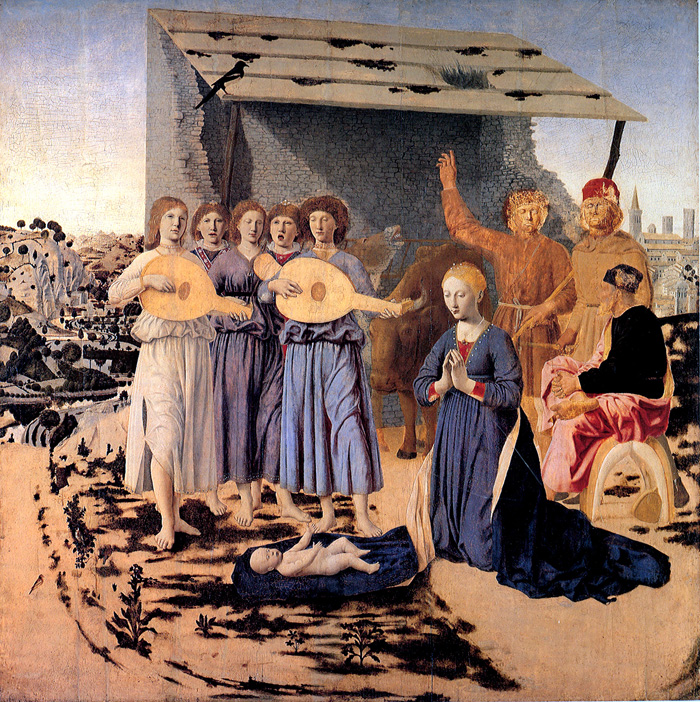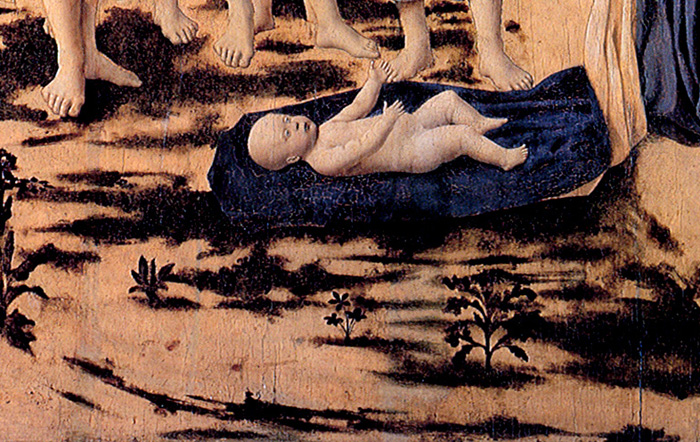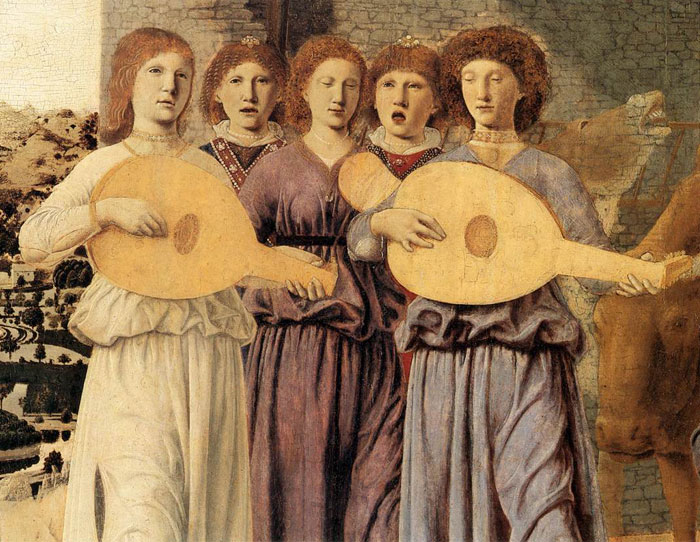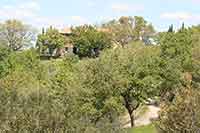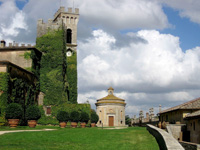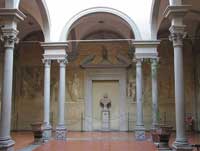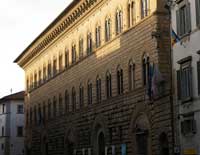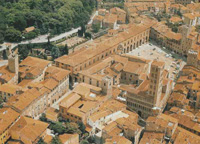Among Piero's surviving paintings, the last one in chronological order is the Nativity in the National Gallery in London. The missing patches of colour, which might almost indicate that the painting is unfinished, are in fact probably the result of overcleaning.
Piero della Francesca was aware of Flemish painting, as can be seen in his Nativity. He probably knew the art of Rogier van der Weyden and may have met him, for Rogier was in Ferrara the same time (ca. 1450) as Piero. He would certainly have known Justus of Ghent, who served the court at Urbino. The Flemish qualities in Piero's work include his use of the oil paint technique and some iconographic types, such as the Madonna del Parto and the Madonna of Humility in the Nativity.
It is possible that this panel was never completed. It has certainly been damaged, possibly by the work of a 19th-century restorer. Nevertheless, the painting holds more than enough detail to give a sense of a complete composition, one which is likely to have been among the last the artist created.
This scene in Nativity shows Mary kneeling in adoration before a newly-born Christ who is laid on her cloak. Five angels sing welcoming his birth - two of them play lutes. Beside them a donkey appears to bray, while an Ox peers down solemnly at Christ.
The Child lies on the ground, on a corner of Mary's cloak, following traditional Northern iconography which is reflected also in the features of the Child. Other elements of Northern culture can be found in a few naturalistic details, interpreted in a highly original fashion by Piero, such as the strange figure of St Joseph, nonchalantly sitting on a saddle, or the two animals in the background, depicted with great realism. No landscape view of Piero's is as miniaturistic as the city depicted in the background at the right: even the streets and the windows of the buildings are visible, just like in a landscape by Petrus Christus. Even the composition of the painting is quite innovative compared to Piero's previous production. The wide expanse of ground, dotted with patches of grass, and the roofing of the hut, with its shadow projecting onto the ruined brick wall, seem to indicate an attempt by the artist to fragment the space of the picture, breaking the rule that he had always rigorously abided by. The vanishing point is slightly raised, as in the Brera altarpiece, and gives one an almost bird's-eye view of the spectacular river landscape, which extends into the distance with trees, bushes and sheer rockfaces that remind one of some of the young Leonardo's drawings.
These aspects of new perspective composition, of experimental naturalism and even of movement must be read as symptoms of the aging painter's incredible ability to update his art to the latest novelties being developed by Florentine and Netherlandish artists. But it is also clear that Piero could not have gone any further in this direction, for it would have meant abandoning the basic principles of his art. The directions that painters like Verrocchio and the young Leonardo were taking, with their almost scientific studies of action and movement, were leading too far away from the principles of spatial construction elaborated and developed by Piero and Alberti. Piero della Francesca's background culture, still very much alive in this last painting in the group of angels clearly inspired by Luca della Robbia's Cantoria in Florence Cathedral, was the 'heroic' environment of the early Renaissance, created in Florence by Brunelleschi and Donatello, by Leonardo Bruni and Paolo Toscanelli. Compared to the ideals of the earlier generation, the refined and courtly culture which was developing around the artistic patronage of Lorenzo the Magnificent, with its poetic Neo-Platonic abstractions and its archeological nostalgia for the romantic nature of classical antiquity, must have seemed superficial and ephemeral - almost a betrayal of its origins.
|
Two shepherds are present (their faces have lost detail, possibly through over-zealous cleaning by previous owners). One of the shepherds points heavenwards, clutching his staff like a sceptre. Joseph is shown in deep contemplation, with his leg crossed over his knee.
Each person, angel and animal shows a different attitude of reverence towards the infant Christ. Even the magpie, well-known in Piero's native Tuscany for its constant chatter, seems changed and looks to be struck silent.
Piero della Francesca has added other touches from his native region - Bethlehem itself has a distinctly Tuscan feel. The flat land on top of the hill where they stand evokes Tuscany, as does the winding valley to the left. Meanwhile the skyline on the right, dominated by the basilica, could almost be the outskirts of Piero's home town Borgo Sansepolcro.
The influences here come from further a field than Tuscany. The painting shows the impact of Northern European painting. Piero painted with tempera early in his career, but for later works like this one he began working in oil. Along with the use of brown under-painting for the figures, this shows a familiarity with Flemish work. This is reinforced by the slim figure of Christ, who lacks the square muscularity of contemporary depictions from Italy, and is more reminiscent of paintings by artists like Hugo van der Goes.
Piero has also experimented with perspective. It is the only one of his works that shows a building askew from the rest of the composition: this is the simple shed, which reminds the viewer of Christ's humble beginnings.
|
![]()

